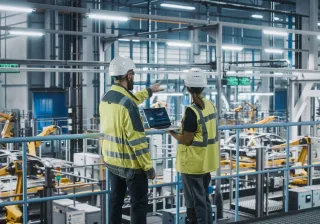Pandemics, geopolitical conflicts and the fight against global warming have led to organisations searching for ways to create industrial sustainability and self-sufficiency. Sustainable, autonomous production processes improve efficiency, resilience and employee satisfaction. Getting there requires investments in key areas and the boldness to envision a better future.
To drastically slow down global warming, we need to rethink the way we manufacture goods. The shift towards sustainable manufacturing places an emphasis on recycled materials and green energy, along with resource-efficient, demand-driven production and circular value chains.
In a time when the COVID-19 pandemic and geopolitical conflicts have shaken supply chains across the world, autonomous production has become a key element in remaining industrially self-sufficient. Autonomy includes self-sufficiency in know-how and resources, but it also requires an increase in the level of automation.
Increased autonomy brings significant economic, social and ecological benefits. There are, however, concrete measures that you must take to truly make your manufacturing sustainable and autonomous.
The 6 steps towards sustainable manufacturing
1. Adopt a shared vision and targets
To be a forerunner in sustainable manufacturing, you need a bold vision. You should identify the small targets and end goals that enable you to realise the ideas.
When you have identified your vision, you should include your business partners and customers to see how they could contribute. The parties you might want to involve are:
- Subcontractors that can provide new kinds of products flexibly
- Digital companies that can offer services, software and APIs
- Customers that you want to attract
- Research institutes and universities that can help with R&D.
After involving the necessary parties, you can start setting shared targets and building roadmaps on how to optimise processes and operations and how to leverage proprietary data.
2. Increase data transparency and accuracy
It is vital for sustainable manufacturing to share data between and within organisations. Getting business benefits out of data sharing comes from each organisation identifying the value different kinds of data have both for them and collectively. To optimise shared processes or operations, every organisation involved should have access to relevant data. Shared databases also require clear guidelines and rules between organisations.
There are several questions that you should answer before efficient data sharing is possible:
- Who owns and manages the data?
- How does data ownership change when the data moves from one place to another?
- Can the data be traced? Does every organisation have the necessary cyber security capabilities?
- Who invests in system integrations?
3. Redesign manufacturing processes and lifecycles
Currently, there is a global shortage of various materials and components. Flexible and autonomous manufacturing processes have become increasingly important for businesses of all sizes.
With a clear vision and smooth data flows, it is also possible to start promoting a circular economy. A circular economy requires you to improve the resilience and flexibility of production. If your customer needs a product with a minimal carbon footprint, you should be able to use your network’s data to secure the best possible supply chain for the materials and parts.
4. Redesign products and production
In a circular economy, manufacturing equipment and processes should utilise materials flexibly. Consumer products, such as car models, are becoming increasingly customised. Recycling offers new ways to manufacture environmentally friendly products. Your equipment and manufacturing processes should be able to accommodate new ideas and materials.
Modern products often have in-built smart features that support consumers or end-users. Work stations, for example, can adjust to different temperatures, humidity and user preferences or even to the user’s cognitive state.
To enable these features, you need to rethink your manufacturing technologies, process automation and IoT capabilities. Do you have the means to build an app that lets consumers tailor the product according to their needs? How about manufacturing climate positive products?
5. Develop key capabilities and invest in employees
An organisational transition to sustainable manufacturing comes through highly skilled workers who have adopted the principles of autonomous production processes. This requires changing the paradigm inside your whole organisation and investing in advanced technologies, such as robotics, and the training of employees. When your workers are engaged in interesting and challenging tasks of high value, their job satisfaction will improve.
Autonomous production is, paradoxically, teamwork. You should use your partner network to fill your knowledge gaps.
6. Go beyond
Finally, be bold. If anything was possible, what would you do? What are the business models that could revolutionise the way we work or manufacture? Great business ideas rarely come by setting the bar low.
The metaverse could, for example, be an interesting industrial application in the future. Remote work is already a reality. But what if by combining the real world and virtual reality you could start performing routine industrial maintenance tasks remotely without even visiting the factory?
Are you looking to make your manufacturing operation more sustainable and autonomous? Don’t hesitate to contact us when you are planning your next bold steps!
Download our white paper: Towards Sustainable Manufacturing
This white paper presents a vision of sustainable manufacturing and provides insights into the transformation towards it.






